Périgord: Come Visit
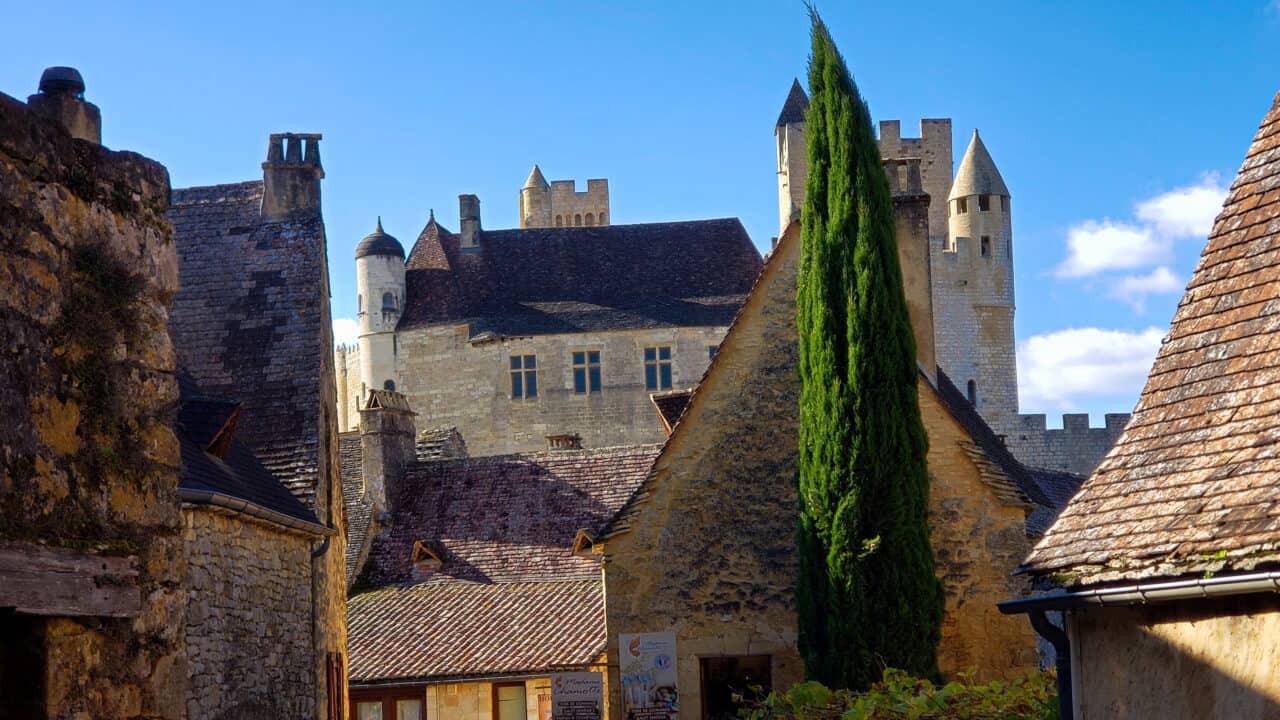
1,000 castles and châteaux are in Périgord, the area where we are camping. The Périgord region is also known by the name of the river we camped beside: the Dordogne. It is a fantastic region. Looking out the front window of our camper is a château on the top of a hill. Looking behind us we can see the unbelievable town of La Roque-Gageac built into the side of a cliff. If you ever get the chance, this area is well worth a visit.
Close to the campground was the town of Sarlat-la-Canéda. As soon as we saw that name we knew that we had to go there for dinner on our first night. We LOVED Sarlat. It is larger than most of the medieval towns that we visit. Mike was impressed with how old it was and how well kept it looked. It had really narrow winding streets, arched passageways, churches and more. We were told that a lot of the British really liked this area and bought homes in town, just outside the medieval centre.
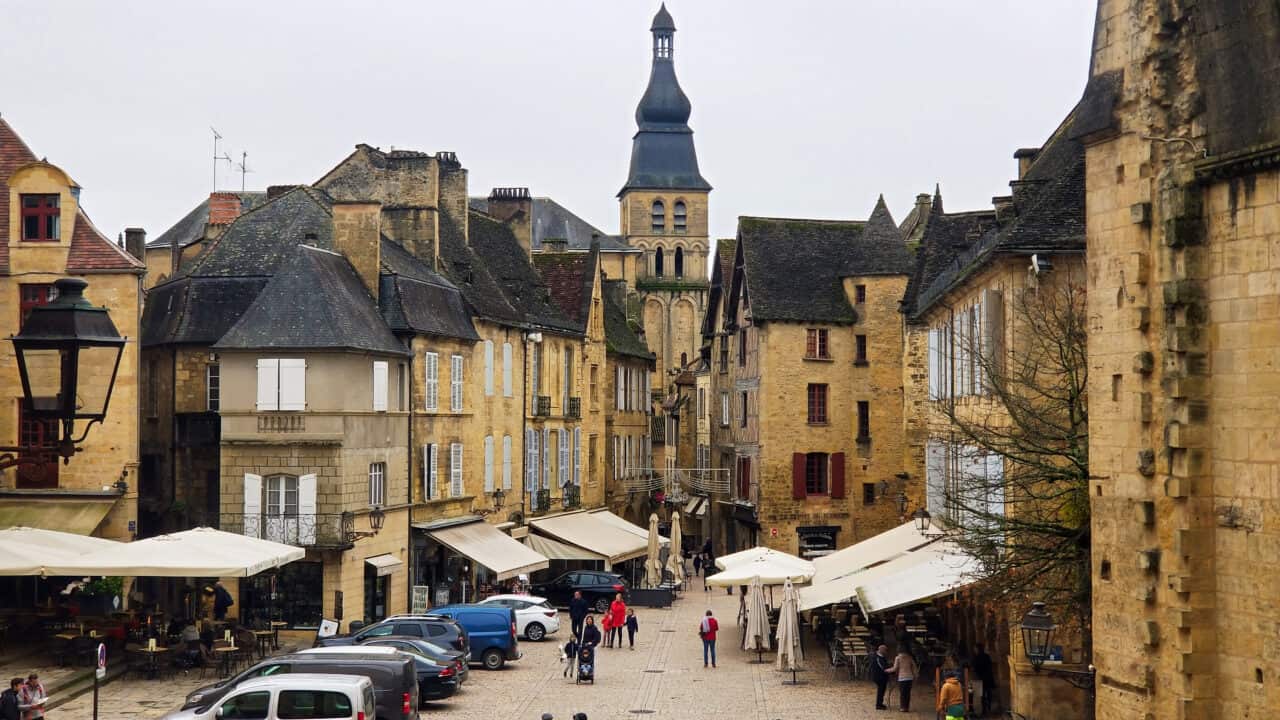
We spent days cycling and driving between the different villages, towns and châteaux. Many of the buildings are built from the local honey-coloured rock which makes them very attractive. One day, the first two villages that we saw were both at the very top of a hill. In both cases, from the town square your view, in every direction that you could see, was over the tops of trees and valleys. You were right on the summit of the hill. This might not be unusual for medieval towns, but it is very nice to see as a visitor.
Right near our camper where five different castles. Two of the castles were right across the river from each other. What made them particularly interesting is that, for much of the time, one was owned by the English and the other was French.
For eight centuries, the two immense stone fortresses faced each other, each one challenging the other over time. The English owned Castelnaud was seized five times during the Hundred Years War but was always immediately taken back by the English. Touring the French Château de Beynac taught us some interesting points about medieval defense and how they thought things through. The front entrance to the castle has a very sharp turn at the drawbridge so that battering rams couldn’t be used. To get into the castle you had to climb a clockwise upward spiral, very uneven and narrow staircase. This slowed down the attackers and only allowed one up at a time. Furthermore it gave right handed swordsman defending the castle more room to swing a sword while descending/defending than it gave an attacker who was ascending the staircase. At the top of the stairs was wider area allowing for a right handed defender to easily use his sword on each attacker as they tried to enter upper chambers of the castle through the stairwell. All this helped with defense but made the castle somewhat uncomfortable to live in.
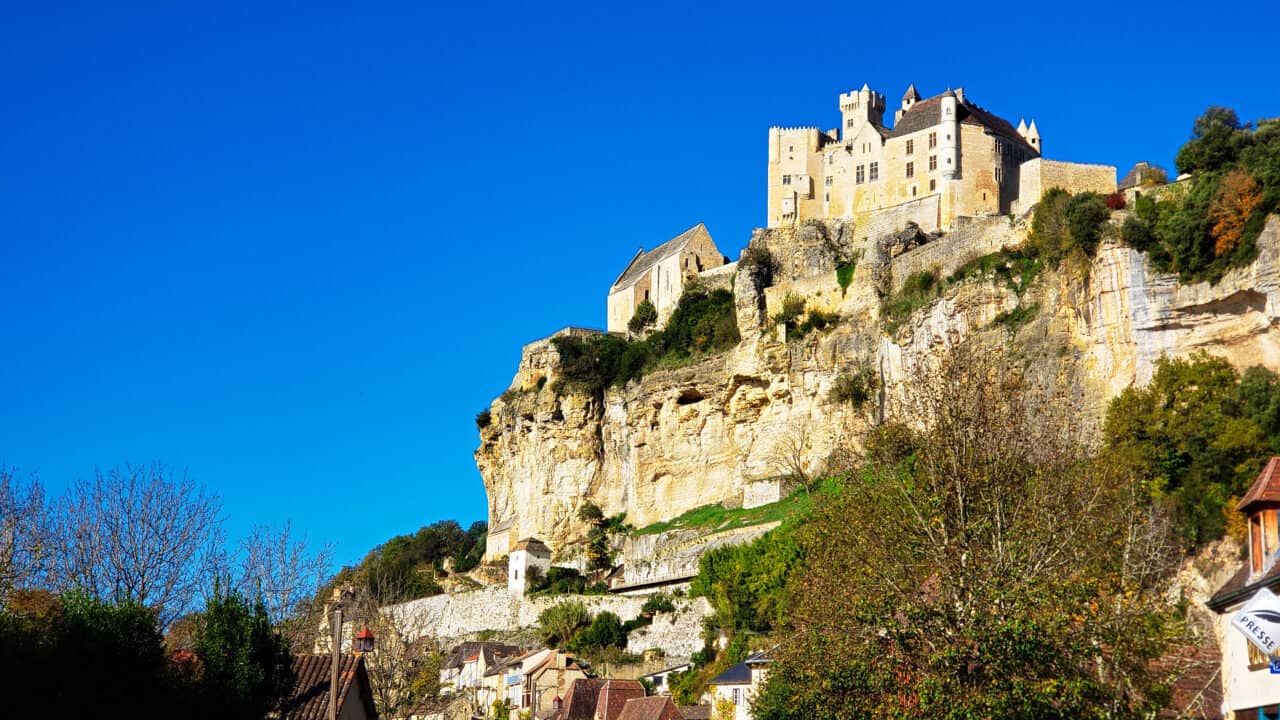
In the 17th C when things had calmed down somewhat, living took priority over defense and a lot of modifications where made to make the castle more comfortable/livable. Mike was quite intrigued with the roofs on part of the castle and the local buildings. The shingles were made out of stone slabs about 10” wide, 12” deep and 1.5” high. This is called a Lauzé roof and would have been extremely heavy. Mike said that the design and installation was such that the walls would carry most of the weight of the entire roof.
On one bike ride we saw a church that Pope Jean-Paul II had visited in 1992 to celebrate the church’s 700 year anniversary. I was impressed and took a picture of the plaque. Two hours later we visited Cadouin Abbey. There we saw a plaque stating that it had celebrated its 900 year anniversary in 2015. I cannot get my mind around the history here. Mike and I love travelling and seeing these places even though the subjects that I hated the most in high school were history and geography. Who knew how things would change.
Around the year 1117 a piece of cloth, regarded as the shroud which had covered the head of Jesus Christ, was brought to Cadouin. This cloth greatly changed the course of the history for the abbey. For the next eight centuries Cadouin became an important shrine for pilgrims. In 1935, after an official appraisal the cloth was declared inauthentic. At this point the pilgrimages just stopped.
Not everything we visit is about olden times. We happened to be in the village of Belvès when they had a free mushroom exhibition going on. It was quite interesting. Who knew that there were that many types of mushrooms. To get into the exhibition they checked that we were double vaccinated and we had to wear a mask. This is the case everywhere in France. The mask was a little awkward as they kept coming around with delicious appetizers and drinks. All the different mushroom displays were labelled as “edible”, “non-edible” or “toxic”. Mike and I were not sure what the difference between non-edible and toxic was. Obviously you had to avoid both. Mike estimated that of the few hundred different fresh mushrooms on display about 25% were edible.
Meal times have been a big problem. Restaurants open late for lunch and close very early. Some reopen again for supper but many, in the tourist villages, do not. Mike and I arrived in one town at about 12:30. I said that I wanted to wander a little before eating. We stopped to eat at 13:25 (1:25 pm) and all the restaurants that had been open were now closed with their doors locked. I think that my hungry husband wanted to kill me. Luckily I did find one restaurant that was just finishing off serving two large parties and agreed to serve us if we ordered very quickly. The meal of the day often includes desert. This restaurant included a lovely flambé Creme Brulé for desert. These daily specials or “menus” as they call them, could be a problem for our waistlines. Luckily we routinely share a single meal.
Here is a picture of Mike holding a very large leaf in our campground. These are very common here. I swear that it is a maple leaf. Mike says that there is no way that the trunk of the tree it came from is a maple tree. Whatever it is, it is extremely common.
The region of Périgord is divided into 4 areas: white, black, green and purple. We were in Black Périgord. Some consider it the cradle of mankind. There is so much to see that we never got to. In Black Périgord there are lots of prehistoric caves, some with phenomenal paintings in them. There are Roman ruins and most of the historical sites and castles in the region are in Black Périgord. We spent six nights here and would love to have been able to spend more time and see this area slowly and in-depth.
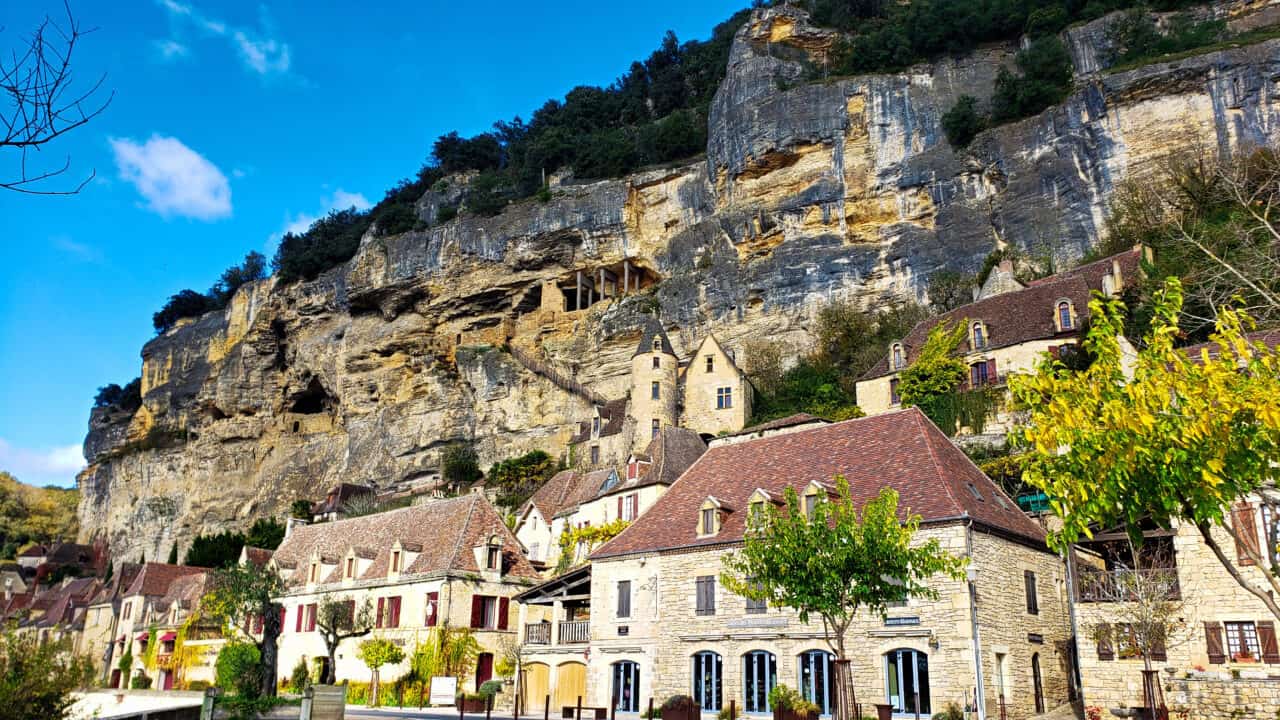
Just down from our campground was the unique fort and village of La Roque-Gageac. A troglodyte is a human cave dweller. The Fort de la Roque-Gageac is known as a troglodyte feudal castle and is built into a crevice in the limestone cliff. In 2010 the roof of the fort collapsed causing a major landslide and leaving a 320-ton rock threatening to fall on the village below. 10 years were spent shoring up the fort and making it safe again. They installed 18 columns holding up the roof which you can see in the middle of the picture above. Look at the picture carefully and you will see openings in the cliff that are part of the “fort”. Nobody ever lived permanently in this fort, it was all about defense and the views over the valley. People would move into the fort for safety during periods of attack.
You can take a cliffside staircase up to the fort and see the remnants of its defensive system. You can also look out over the river and valley and enjoy was is said to be a tremendous view. Here is where I have to admit that we stayed in the village and didn’t climb up the staircase. The one thing about staying in an area with lots of châteaux is that they all have lots of stairs and my knees where not very happy with me. The thought of climbing the “breath-taking” cliffside stairs, no matter how much I wanted to see what was up there, was not happening on this day.
The capital of Périgord is the city of Périgueux about an hour from our campground. We had to drive right past Périgueux on our way west so we decided to stop somewhere for the night and make a quick visit into the city. There was a restaurant, not too far off the main highway, that had a parking lot for cars and another parking area for trucks. We had a large lunch in the restaurant and then camped there for the night at no charge. We had a few trucks join us during the night. It was very convenient and much less noisy than some of the highway truck stops. Mike did say that using the generator the way we do for the TV and computers was noticeable on our fuel gauge the next morning. The campsite might be no charge but the fuel we use for the generator is very expensive. Normally we would have spent more time in this area but again, we were trying to head fairly quickly towards our winter destination.
One last item of interest. Just down from our campground, near the village of La Roque-Gageac is the Château de la Malartrie. You can see it on the left of the picture below. This château is available for rent starting at 5000€ ($7,200 Cdn) per week for 14 people. The Château de la Malartrie website says that you can rent the castle of your dreams and it even has a swimming pool.
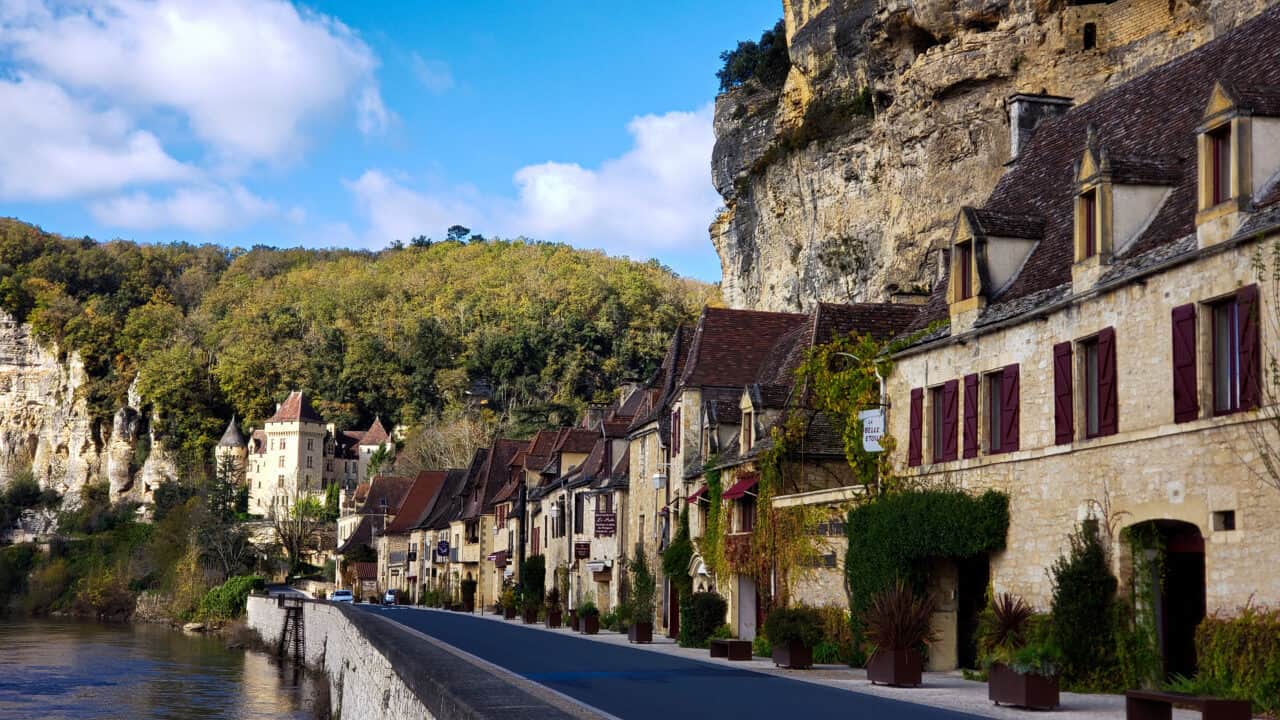
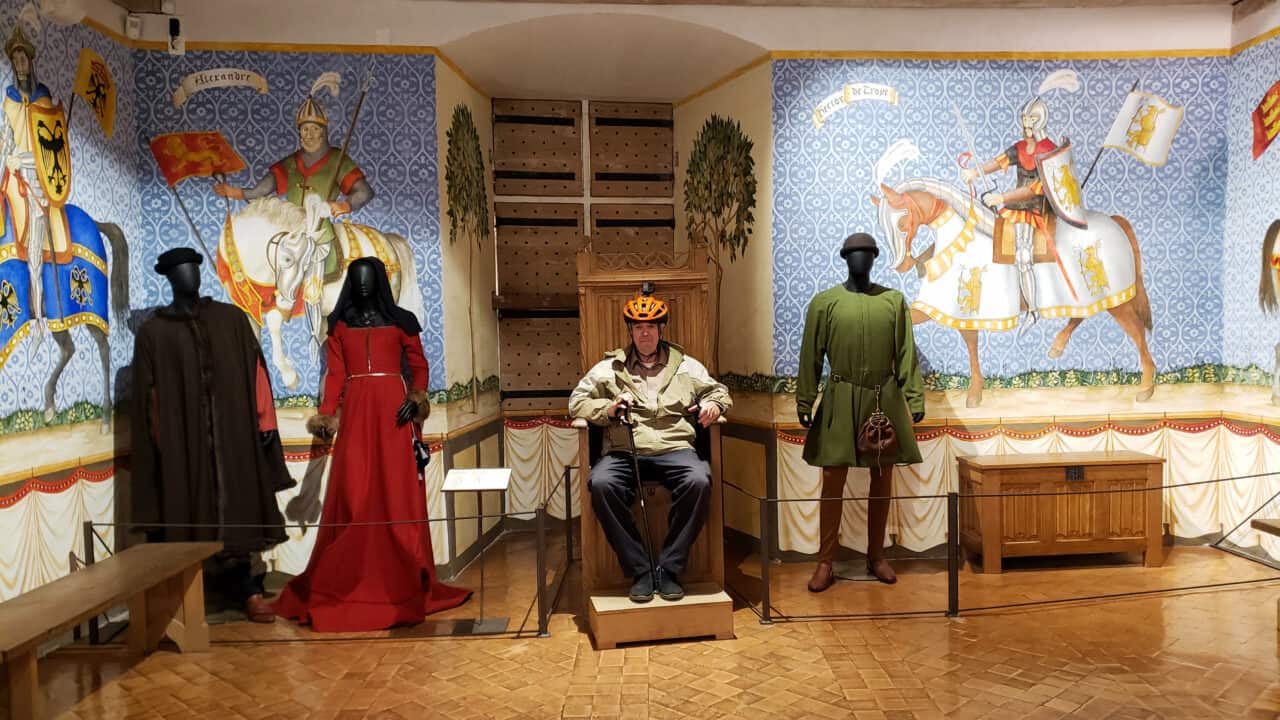

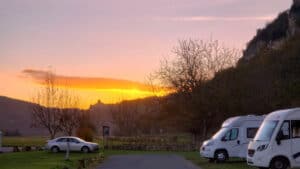
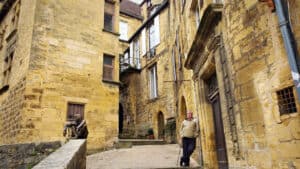
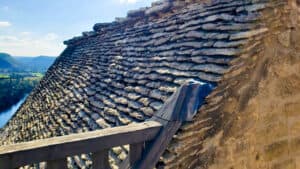
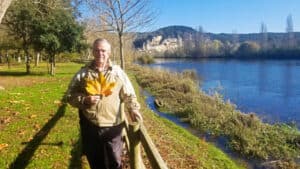
Leave a Reply